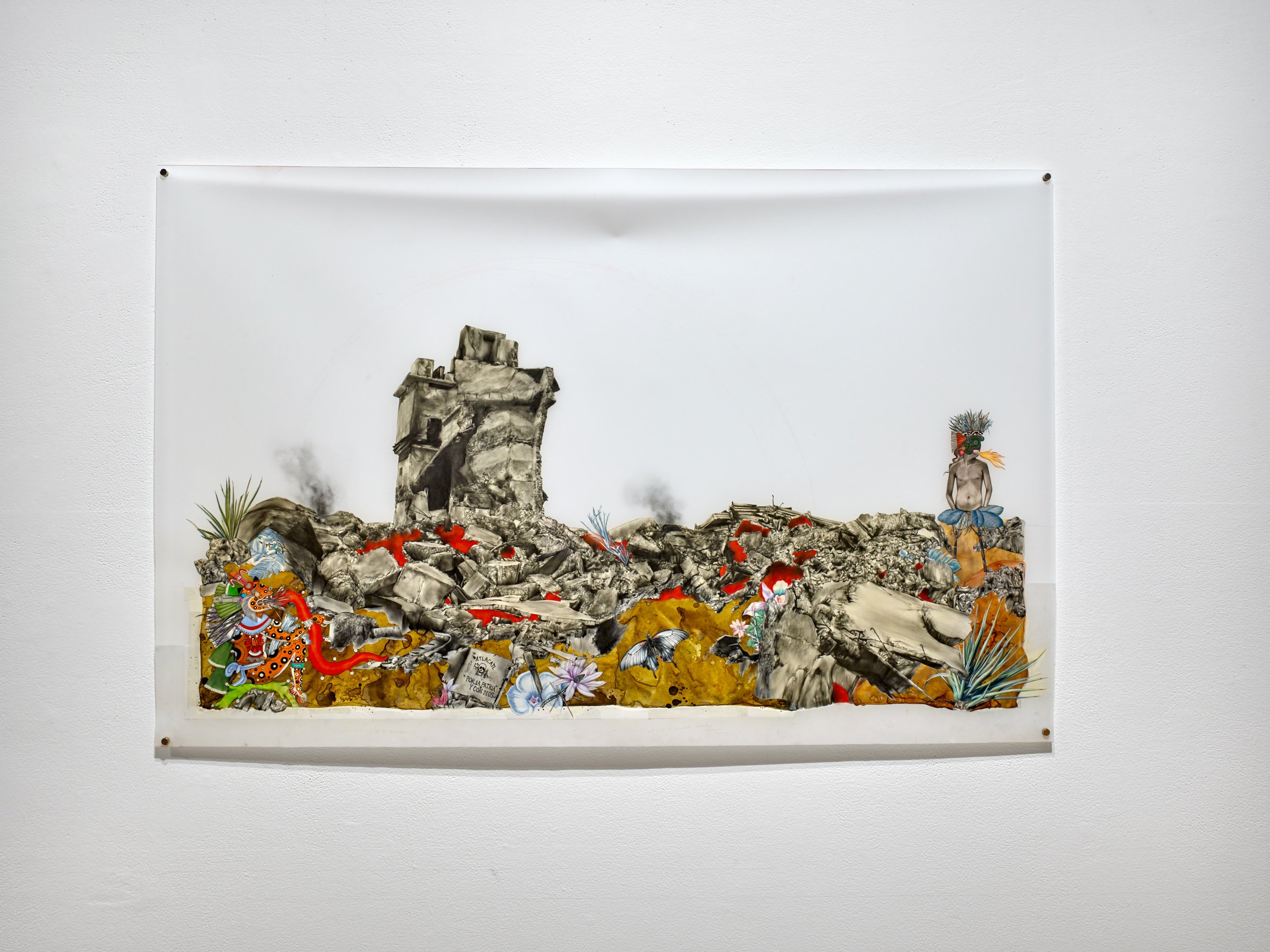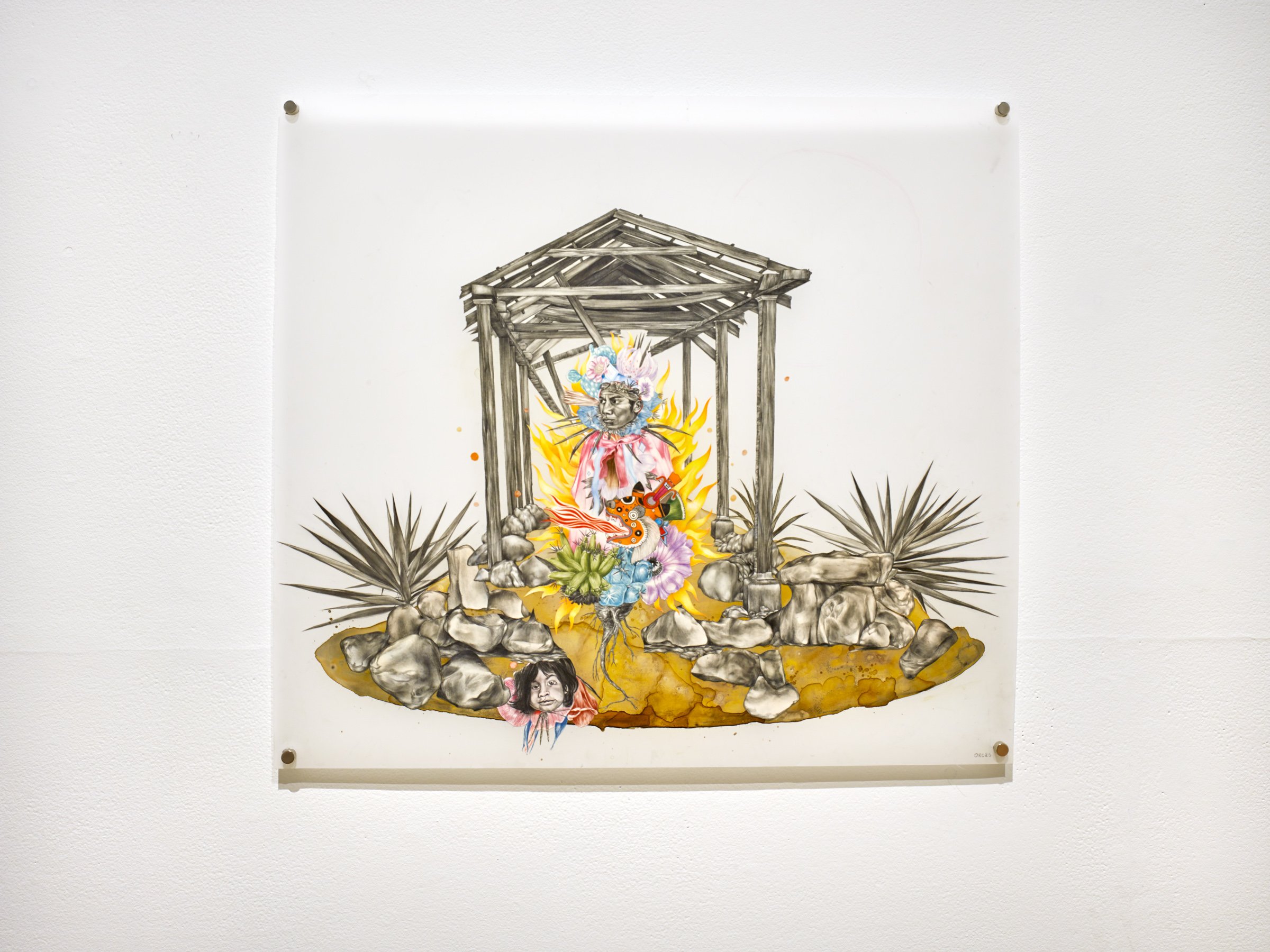Regarding the Anti-Monument
The Drawings of Osvaldo Ramirez Castillo
Osvaldo Ramirez Castillo, Refuge, 2015. Mixed media on mylar. Courtesy of the artist. Photo: Biff Henrich.
We are the sum total of our experiences — whether we like it or not. For Osvaldo Ramirez Castillo, these begin with fleeing political violence in his native El Salvador at age eleven. His numerous mixed-media drawings, prints, and the occasional stop-motion video and site-specific installation delve into this traumatic history. As the artist himself explained, “I am searching for a language of reconciliation or healing — what that might look like and how it is an ongoing process.”
I interviewed Ramirez Castillo on the occasion of his latest solo exhibition, Ruinas, at Buffalo’s Hallwalls Contemporary Arts Center in the spring of 2022. An hour flew by between my nonlinear questioning and the artist’s multilayered and richly interconnected responses. What follows focuses on central themes and key takeaways from our discussion.
“How did you and Buffalo meet?”
Some in the greater Buffalo and southern Ontario region might recognize Ramirez Castillo’s name from the 2007 edition of Beyond/In Western New York. That year, Ramirez Castillo’s presentation at Buffalo Arts Studio featured his Discovery of Shoes (2006): a haunting and poignant drawing of children, faces smudged, gathering at a gravesite covered in a pile of shoes. Ramirez Castillo’s ochre and black–shaded vision of intense collective grief and inconsolable pain transcends any one loss, however. Returning to the work some sixteen years later, it seems a sobering portend of the children’s shoes placed at the sites of former residential schools across Canada in response to the recent discoveries of unmarked graves there.
In the Beyond/In catalogue, curator Brooke Leboeuf writes:
French author Marcel Proust explains memory in his classic novel Remembrance of Things Past: ‘The moments of the past do not remain still; they retain in our memory the motion which drew them towards the future.’ For Ramirez Castillo, the past neither remains in El Salvador nor is it passively invoked. Rather, it stays with him, moves with him, and demonstrates a rapidity all its own, expressed in his images of chaotic throngs and desolation in the aftermath of violence. [1]
Ramirez Castillo describes to me how “healing can be like a shooting target.” The burden of history continues to move with him through his personal reconciliation process and artistic journey. It is not uncommon for diasporic artists to initiate a dialogue with their roots, and for Ramirez Castillo as for so many of his peers, reflecting on a personal geography charred by traumatic history remains a significant and ever-evolving task. Scholar Kency Cornejo, herself the daughter of Salvadoran immigrants, contends that artists from Central America’s Northern Triangle (Guatemala, El Salvador, and Honduras) “offer a visual thinking that reflects a way of being and living in a world from a specific geopolitical space and embodiment.” [2] Grappling with Ramirez Castillo’s work compels recognition and honoring of the cultural and geographical origins of his experiences; his is no view from nowhere.
Osvaldo Ramirez Castillo, Ruinas 2, 2022. Mixed media on mylar. Courtesy of the artist. Photo: Biff Henrich.
Geographical and diasporic context has only become more integral to Ramirez Castillo’s artistic production in the intervening decade and a half since his first exhibition appearance in Buffalo. Ruins and all that they imply (grief, loss, the end of a world, etc.) are omnipresent in his most recent bodies of work. As curator John Massier aptly notes in the catalogue for 2022’s Ruinas, “History, memory, and identity combine in these works to become complex emblems of a rich, personal iconography.” [3]
“Years of Processing”: Ramirez Castillo’s Aesthetic Shift and Use of Nature as Metaphor
Natural imagery and floral symbolism fill Ramirez Castillo’s more recent work, the end product of what he describes as “years of processing.” In Guerilla Monument (2017), for instance, richly colored flora emerge from the decapitated torso of a soldier, propped upright on scaffolding evocative of a scarecrow.
Ramirez Castillo explains that indelible memories of childhood visits to a countryside divided by wood fences inform his current interest in scarecrow imagery. For the artist, the scarecrow offers a means of confronting the past and visualizing an anti-monument to the fragmentary legacies of violent conflict. “I have always been fascinated by the power of an image,” Ramirez Castillo explains. “I think in social and political metaphors with images found in pre-Hispanic mythology. If one delves into the research of how Catholic, syncretic iconography came about, one can discover the remnants of pre-colonial imagery. Two worlds colliding together.”
Osvaldo Ramirez Castillo, Scarecrow I (left), 2015 and Soldier Overgrowth I, (right) 2021. Mixed media on mylar. Courtesy of the artist. Photo: Biff Henrich.
Empowering A Caring Collective
While Ramirez Castillo does not consider himself an activist, he recognizes how his work might provoke greater caring, awareness, and even political action on the part of his viewers. As Massier writes in his essay, “You are drawn toward [Ramirez Castillo’s drawings] and then gut-punched by the imagery coming into focus.” [4]
Beyond their often luridly rendered details, drawings such as Refuge (2015) are replete with subtextual references to compassion and empathetic connection. Here, a child curls in a fetal position beneath a dilapidated shed and a shadowy haze evocative of lingering gun smoke. Large portions of the background appear blank, as if we are witnessing an only semi-recalled memory. The fundamentally human vulnerability of Refuge’s protagonist calls forth a wish to help others and to ease suffering in the world (even if cynicism deems this to be a tall order). As a whole, Ramirez Castillo’s installation at Hallwalls does not shy away from, but never simply wallows in, the obscenities of manufactured destruction and the types of cruelty that upended and altered his life.
Osvaldo Ramirez Castillo, Lost Underground Radio 2, 2022. Mixed media on mylar. Courtesy of the artist. Photo: Biff Henrich.
A Sense of Possibility Persists Throughout Ruins
For Ramirez Castillo, trauma and hope trace nothing so simple as an either/or binary but instead figure a complex entanglement of mutual, uneasy coexistence. His ruins, Massier writes, “ultimately reveal themselves as spaces for new growth. A sense of possibility persists throughout.” [5]
The artist remarks to me, “Ruinas is such a great metaphor — whether it is a tragic past or the connotation of Indigenous heritage. Quite literally, Mayan ruins contribute to the geological and archeological landscape of the country. It also speaks to our Indigenous history and part of our living memory.” His drawings transport the viewer into a mediated plane of resistance and renewal, a plane where the present grows wildly out of pasts personal and cultural.
This present is no anodyne utopia, however, as Ramirez Castillo knows all too well. As Cornejo observes, “Violence has not ceased for postwar Central Americans, and those who managed to survive the inhumanity of war face new manifestations of violence in its aftermath.” [6]
Ramirez Castillo’s process of repair and healing from these violences and their aftermath as captured in his small, luminously dense drawings moves me deeply. And as our conversation wrapped, I told him so: how much I valued his strength in channeling his personal experiences into art. His wrenchingly beautiful images articulate the anti-monument in a provisional state of becoming, as part of a long-lasting journey through history, memory, and change to come.
Osvaldo Ramirez Castillo, Nahual Refuge, 2022. Mixed media on mylar. Courtesy of the artist. Photo: Biff Henrich.
Writer’s Note: I wish to thank the past and present staff at Buffalo Arts Studio and Hallwalls Contemporary Arts Center for making these exhibitions happen and for providing me with archival materials essential to the writing of this article. But I owe my greatest debt of gratitude to Osvaldo Ramirez Castillo for taking a moment to speak with me and upholding his truth-telling.
1. Brooke Fitzpatrick, “Osvaldo Ramirez Castillo” in Beyond/In Western New York 2007 (Buffalo: Albright-Knox Art Gallery, 2007), 66.
2. Kency Cornejo, “Visual Counter Narratives: Central American Art on Migration and Criminality,” Journal of Commonwealth & Postcolonial Studies 5, issue 1 (Spring 2017): 78.
3. John Massier, Osvaldo Ramirez Castillo: Ruinas (Buffalo: Hallwalls Contemporary Arts Center, 2022), 3.
4. Ibid., 4.
5. Ibid., 4.
6. Cornejo, “‘Does That Come with a Hyphen? A Space’: The Question of Central American–Americans in Latino Art and Pedagogy,” Aztlán: A Journal of Chicano Studies 40, no. 1 (Spring 2015): 190.







